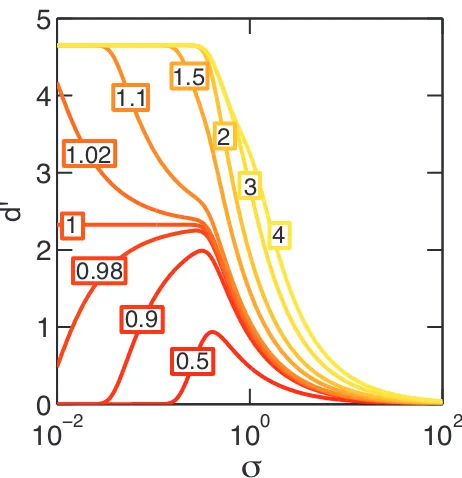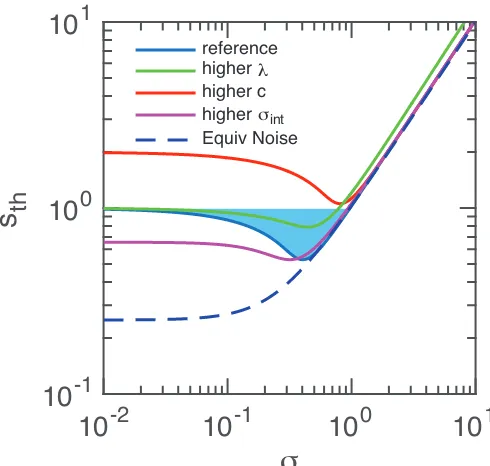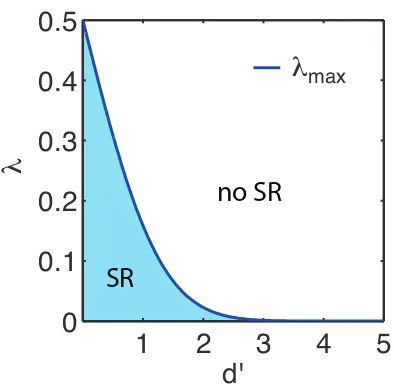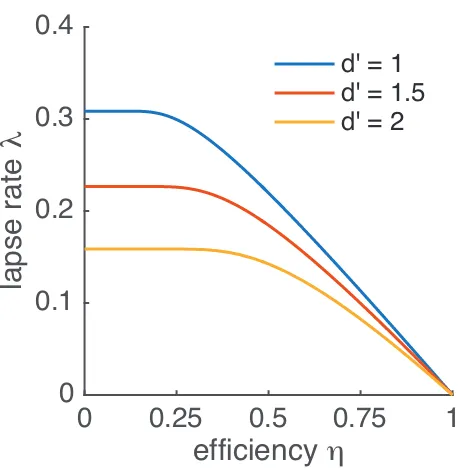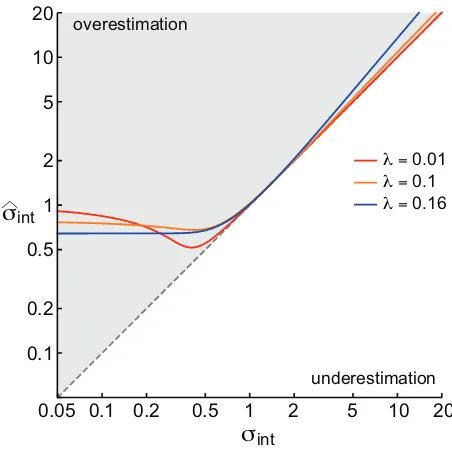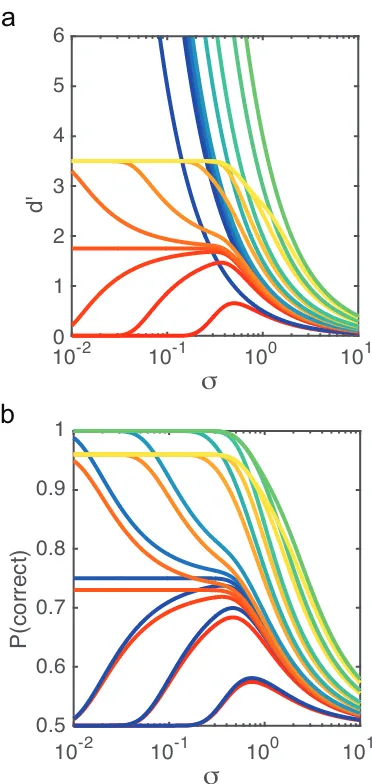arXiv:1711.04950v1 [q-bio.NC] 14 Nov 2017
Modelling stochastic resonance in humans: the influence of lapse
rate
Jeroen J.A. van Boxtel∗
School of Psychological Sciences and Monash
Institute of Cognitive and Clinical Neurosciences,
Monash University, Clayton 3800 Vic, Australia
(Dated: November 15, 2017)
Abstract
Adding noise to a sensory signal generally decreases human performance. However noise can improve performance too, due to a process called stochastic resonance (SR). This paradoxical effect may be exploited in psychophysical experiments, to provide additional insights into how the sensory system deals with noise. Here, I develop a model for stochastic resonance to study the influence of noise on human perception, in which the biological parameter of ‘lapse rate’ was included. I show that the inclusion of lapse rate allows for the occurrence of stochastic resonance in terms of the performance metricd′. At the same time, I show that high levels of lapse rate cause stochastic resonance to disappear. It is also shown that noise generated in the brain (i.e., internal noise) may obscure any effect of stochastic resonance in experimental settings. I further relate the model to a standard equivalent noise model, the linear amplifier model, and show that the lapse rate can function to scale the threshold versus noise (TvN) curve, similar to the efficiency parameter in equivalent noise (EN) models. Therefore, lapse rate provides a psychophysical explanation for reduced efficiency in EN paradigms. Furthermore, I note that ignoring lapse rate may lead to an overestimation of internal noise in equivalent noise paradigms. Overall, describing stochastic resonance in terms of signal detection theory, with the inclusion of lapse rate, may provide valuable new insights into how human performance depends on internal and external noise.
I. INTRODUCTION
The brain is an inherently noisy system; much of the brain’s activity is not driven by external stimulation, or by purposeful internal processes, but by seemingly random activity: noise. Noise poses a fundamental problem for information processing [1, 2] as it increases variability and limits the clarity of a signal. Yet, given the abundance of noise in neural processing, the brain still achieves remarkably stable perception, presumably because the brain adapted to its own noisiness and that of its inputs. Therefore, studying how the brain responds to noise may help reveal the internal workings of the brain.
Noise is often considered to limit optimal performance [1, 2]. Indeed the very definition of the performance metric d′ is signal-to-noise ratio, where increases in noise decrease d′ [3]. While noise is expected to degrade performance in general, noise can actually improve performance. For example, noise can push a subthreshold signal — that would normally lead to chance performance in behavioral tasks— above threshold, and thereby lead to above-change level performance, an effect called stochastic resonance (SR) [4]. Note that SR here refers to any occasion where noise increases performance, and not just cases with periodic input [4]. SR causes optimal performance (i.e., highest detectability) to be reached at non-zero levels of noise. This has potentially important implications, because it suggests that inducing SR by adding noise can be used to boost performance of humans and machines. Because of this potential beneficial effect of noise, it is useful to study SR in more detail, specifically in relation to human performance.
In humans, the influence of noise on performance or perception is often investigated using paradigms in which external noise is added to the signal, and performance thresholds are measured [5]. A common method is called the equivalent noise (EN) paradigm, which is often used to estimate internal (brain-generated) noise [5], and has its origins in engineering to measure noise dependence in electronic amplifiers [6]. In the EN paradigm, the overall noise σ is assumed to be a combination of internal noise σint and externally added noise
σext, whose variances add: σ2 = σ2int+σ2ext. In experimental settings, various amounts of
external noise are added to a signal and the effects on detection thresholds are mapped out. When σext ≪ σint, only internal noise limits performance. At high levels of external noise
(σext ≫ σint), performance is determined by external noise. At intermediate amounts of
which is located at the level where internal and external noise are equivalent; the location of the elbow thus represents the level of internal noise.
Although extensively used, the EN paradigm often only considers 2 parameters of interest (i.e., internal noise, and efficiency). Although several extensions on the basic EN paradigm exist [5] they almost invariably assume that the brain is optimal at setting decisions thresh-olds. However, human observers do not always set decision thresholds optimally [3]. This sub-optimal behavior allows for SR [7], which indeed has been reported in human observers [8–12]. The fact that SR occurs indicates that the effects of noise are more complicated than often modelled in EN approaches.
Stochastic resonance has been extensively investigated from an engineering point of view, but less so in humans. A good description of SR in humans is more complicated because the human sensory system presents some challenges in researching stochastic resonance. First, the noise may originate from one of many processing levels in the brain, from early sensory, to later decisional stages, each potentially having different effects on performance. Second, humans are not machines, and they suffer from attentional lapses (induced by, e.g., decreased arousal or vigilance). The influence of attentional lapses has not been studied in the stochastic resonance literature. To determine the optimal level of external noise to achieve optimal performance (i.e., maximal SR), these two specifically human challenges need to be better understood.
Here, I model the influence of noise in sensory signals and decision criteria. To provide further insight into the usefulness of SR as a measure of the influence of noise on human perception, I will compare this model to the EN paradigm [5, 13].
II. A SIGNAL DETECTION MODEL OF STOCHASTIC RESONANCE
Previous work has shown that signal detection theory can provide a good framework for modeling stochastic resonance in human behaviour. Gong et al. [7] used the following equations:
H =
Z ∞
c
N(s, σ2) (1)
F =
Z ∞
c
N(n, σ2) (2)
p= 1
where H is the hit rate, and F is the false alarm rate,cis a criterion (i.e., threshold), sis the signal strength,n is the mean noise strength, N(.) is the normal distribution with a certain mean (s or n) and variance (σ2). The variable σ represents the noise in the system. This
model produced SR for accuracy (p), when c > s.
This model also predicted that in the limit of zero noise, d′, another measure of (human) performance, increased to infinity. Although this may make sense whend′ is interpreted as a signal-to-noise ratio, it does not when d′ is considered a metric of human performance. As a measure of human performance, d′ should drop to chance level when noise is decreased, just as accuracy does. Therefore, I extended the model presented in [7], with another human characteristic, namely lapse rate λ.
H =λ+ (1−2λ)
Z ∞
c
N(s, σ2) (4)
F =λ+ (1−2λ)
Z ∞
c
N(n, σ2) (5)
d′ = Φ−1(H)−Φ−1(F). (6)
where d′ is an unbiased measure of performance, λ is the lapse rate (0≤λ ≤1/2) , Φ−1 is
the inverse of the cumulative normal distribution function. The variable σ again represents the noise in the system, but for our purposes it is important to realise that this noise can have an external (σext) or internal (brain-generated; σint) origin, as σext is under control
of the experimenter, while σint is an internal property of the system under study, i.e. the
human participant.
The lapse rate λ represents the proportion of guesses that a participant is required to make due to not paying attention to the stimulus. When 0< s < c(i.e. sub-threshold) andσ
is small, H and F approachλ, andd′ approaches 0, as required for a measure of performance. Importantly, without the inclusion of λ, both H and F approach 0 as σ decreases, but F much faster then H, because n < s, leading d′ to increase drastically (see equation 6).
Whenλ >0, the model can produce SR ford′, as shown in Fig. 1 in which the dependence
10
−210
010
2 while the different lines are solutions at different values ofs(indicated with the boxed numbers).d′ does not increase to infinity (as was found by [7]), but instead
lim
This behaviour is consistent with human performance, where subthreshold signals (i.e.,
s < c) lead to chance performance, and supra-threshold performance is limited by attentional
lapse rate.
III. DETECTION THRESHOLDS
By solving eq. 6 fors, one can calculate the threshold signal strength sth, and thus TvN
where erf and erf−1 are the error function, and inverse error function, respectively. Note that
we will use the superscript SR to refer to sth specifically in equation 8a. When referring to
the threshold signal strength more generally, no superscript it used. In this paper, we will assume n= 0.
When λ= 0, this equation reduces to a straight line
sth=d′σ, (9)
independent of the criterion, and without a possibility to yield SR. Rewriting eq. 9 yields
d′ =s
th/σ, which is the signal-to-noise ratio [c.f., 7].
When taking λ > 0, SR is possible. Equation 8a is plotted for various parameter com-binations in Fig. 2. An (arbitrary) base-line curve (blue) describes a characteristic ‘dipper’ function [or threshold-versus-noise (TvN) function], which has been repeatedly reported in the literature for various masking paradigms [14]. The curve shows that the detection threshold is lowest at intermediate noise levels σ, characteristic of SR (highlighted in blue shading). In the following sections, the influence of various factors on the shape of this curve, and the appearance of stochastic resonance are investigated.
A. The influence of λ
First, the influence of lapse rate λ is investigated. With an increase in λ (green line;
λ = 0.07) relative to the reference curve, SR decreases in magnitude, and the point of maximal SR moves to higher noise levels. The maximum level of λ before SR is lost can be calculated by setting eq. 8b to zero. Solving for λ in the limit of zero noise gives the maximum value of λ (i.e., λmax):
10
-210
-110
010
1σ
10
-110
010
1s
threference
higher c higher σint higher λ
Equiv Noise
FIG. 2. Dependence of detection thresholdsth on noise σ. All parameters are as for the reference
line (and as in Fig. 1), except where otherwise specified. Reference: d′ = 1,c= 1,λ= 0.01; higher c: c= 2; higherσint: σint = 0.25; higherλ: λ= 0.07; Equivalent Noise: σint= 0.25,λ= 0,c=s/2.
For the ‘higherσint’, and ‘equivalent noise’ curves, the x-axis represents σext.
Figure 3 shows the dependence of λmax on d′. At d′ = 1, a typical value of d′ in
psy-chophysical experiments,λmax≈0.1587. This level ofλmax is high compared to typical lapse
rates around 0.06 or less [15], and suggests that λ is not a limiting factor on the occurrence of SR in many experiments.
A final observation is that the effects of λ remain visible at large values ofσ, while other factors, discussed later, do not have a mayor effect at large σ (see Fig. 2).
B. The influence of criterion, and decision noise
1
2
3
4
5
FIG. 3. The maximum lapse rate, dependent ond′. The shaded area allows for SR.
prevent many false positives, but low enough to prevent too many misses. Thus, where c is put determines how liberal or conservative the decision stage is. A ‘present’ response could have the requirement that the decision signal is larger than the Pth percentile of response distribution in the decision stage in the absence of input (i.e., purely noise-driven activity in the decision stage, here assumed to be normally distributed). Assuming an unbiased (mean = 0) but noisy response originating from the decision stage, the criterion should be set at
c=σdΦ−1(P). (11)
Therefore, c can be interpreted as reflecting noise in a post-sensory decision stage. If σd
increases, so does c, which results in an upwards shift in the detection threshold sth, as can
be observed in Fig. 2. Conversely, because SR can only occur whenc > s, systems with low decision noise (or alternatively, very liberal systems with a low p) will not show SR. The condition for SR is that
σd >
s
Φ−1(P). (12)
As an aside, in signal detection theory, optimal performance on a task is reached when the criterion is set between mean of the signal and noise distribution (see e.g. [3, 7]). In our case this means c = s/2. Because c is smaller than s, no SR will occur (see also [7]). However, because c is larger than zero, the optimal decision noise σd is, counterintuitively,
larger than zero:
σd =
s
This conclusion is consistent with a recent analysis on economic decisions making [16].
IV. THE INFLUENCE OF INTERNAL NOISE, AND A COMPARISON TO THE
EQUIVALENT NOISE PARADIGM
In our model, the noise σ is the total amount of noise in the sensory-perceptual system. One can subdivide σ into two independent components: (i) noise that is external to the system σext, and e.g. is present in the stimulus; (ii) noise that is internally-generated σint,
where their variances add. In the equivalent noise paradigm, such as the linear amplifier model [5], this is often rewritten as:
σ =
q
σ2
int+σext2 . (14)
When inserting this into eq. 8a, one can show the effect of adding a constant amount of σint on performance thresholds (Fig. 2; purple line). Increases in σint result in left-ward
shift of the TvN curve relative to the reference curve. The increase in σint simultaneously
results in lower thresholds (better performance) at low σext, while it increases thresholds at
high σext. The former result is due to σint itself causing SR relative to the condition where
σint = 0. In effect, it is moving the SR dip to the left. With even higher levels of internal
noise, the curve is shifted so far to the left that upward arm of the curve at low noise levels, disappears. Even though σint still increases performance relative to the reference curve in
this case, and thus shows SR, it will not be recognised as such because it does not present itself as a dip in the TvN curve. I come back to this in the discussion. Increasing σint even
further will remove SR completely.
A. A comparison to the equivalent noise paradigm
In stead of assuming a fixed criterion c, as in the derivations above, the equivalant noise paradigm assumes that the decision criterion is set optimally, i.e, c = s/2. When this is inserted into eq. 6, and deriving the threshold performance, we obtain:
Setting λ = 0 (one of the assumptions often made) results in the standard dependence of the detection threshold on internal an external noise
sEN
th =d′ q
σ2
int+σext2 (16)
(when d′ is set to 1). This dependence is plotted in Fig 2 (dashed curve). Due to the fact
that c < s, there is no SR possible in this description of human performance.
B. The relationship between λ and efficiency η
Because measured thresholds in psychophysical experiments are often higher than the optimal thresholds, the EN paradigm often includes an “efficiency” parameterηwhen fitting the curve to experimental data:
where η <0, which scales the curve up (i.e., higher detection thresholds).
When reordering Eq. 15 one can see thatλprovides a scaling factor in our model, similar toη in equivalent noise paradigms. This relationship makes intuitive sense, as an increased number of lapses, decreases efficiency:
where AE is a constant, and related to the calculation efficiency (cf. [13]), but here abbre-viated as AE (attentional efficiency) to capture the fact that it is determined by attentional lapse rate λ:
0
0.25
0.5
0.75
1
efficiency
η
0
0.1
0.2
0.3
0.4
la
p
se
ra
te
λ
d' = 1
d' = 1.5
d' = 2
FIG. 4. The relationship between efficiency parameterη in equivalent noise paradigms, and lapse rate λ.
This relationship is plotted in Fig. 4 for different values ofd′. These results show that lower efficiency can be captured by increased lapse rates.
Overall, the comparison between our model and the equivalent noise paradigm (specifi-cally, the linear amplifier model) suggests that ηcan expressed in terms of λ, and thus that lapse rate λ may explain at least part of the suboptimal efficiency (i.e., η <1) that is often reported in psychophysical experiments.
C. The pooling parameter
In some psychophysical experiments, performance thresholds are actually lower than pre-dicted. This would imply an efficiency >1. Generally, however, the results are interpreted differently, with total noise calculated as:
σ=
r
σ2
int+σext2
n , (22)
of samples that are taken to estimate a mean. For example, how many individual moving dots are combined to estimate a global pattern motion [e.g., 17].
Detection thresholds can be obtained from eq. 8a or eq. 9, by replacingσwithp(σ2
int+σext2 )/n,
Equation 23 and eq. 17, are very closely related as they describe the same relationship when n is equal to η2.
I set λ = 0, here, because otherwise both η (or λ) and n need to be determined, and as both have the same scaling effect, the system would be underdetermined. However, in experimental settings, unless participants are experienced and extremely motivated, it is unlikely that λ = 0, and thus a correct value of the pooling parameter n can only be obtained if λ is also determined.
D. Overestimation of internal noise in the EN paradigm
When comparing the EN results in Figure 2 to those of the ‘high σint’ condition, one
can observe that the suboptimal positioning of the criterion c in the latter case caused an expected increased detection thresholds at low external noise values (left side of the plot). An important consequence is that the curves are quite different even though the internal noise is the same. Consequently, fitting the equivalent noise function to experimental data with SR will give incorrect (over)estimates of internal noise.
One can approximate the overestimation of internal noise by equating the EN model (eq. 15) and the SR model (eq. 8a) atσext = 0. Then, while taking the noise in the SR equation
as the actual internal noise (σint) and that in the EN equation as the estimated internal
noise (ˆσint), we obtain:
ˆ
σint =s
SR
th/AE, (24)
λ =0.01
λ =0.1
λ =0.16
0.05 0.1 0.2 0.5 1 2 5 10 20
0.1 0.2 0.5 1 2 5 10 20
σint
σint
overestimation
underestimation
FIG. 5. (a) The dependence of ˆσint on σint, when SR data is fit with the EN equation. Internal
noise is overestimated, especially at small levels ofσint.
on various parameters (e.g., λ, c, d′), and on the distribution of external noise values tested in experimental settings, and how much the dip caused by SR influences the EN model fit.
V. STOCHASTIC RESONANCE IN TERMS OF ACCURACY
I have focussed so far on the dependence of SR on d′, because data in terms of accuracy have previously been reported on in a similar model without λ [7]. A direct comparison between the current model and that of [7] in terms ofd′ and accuracy is made in Fig. 6. As one can see, the largest difference is in terms of d′, and not in terms of accuracy. In fact, the level of above-chance accuracy in our model is 1−2λ times that of the model where
λ = 0 [7]. This fixed relationship means the analyses by [7], which rested on finding the point where the derivative of accuracy relative to σ was 0, will remain valid in the current model.
VI. DISCUSSION
10-2 10-1 100 101
σ
0 1 2 3 4 5 6
d
'
10-2 10-1 100 101
0.5 0.6 0.7 0.8 0.9 1
P(co
rre
ct
)
σ
a
b
FIG. 6. (a) The dependence ofd′ on noiseσ. The warm colors are for the current model, the cold colors are for those of [7]. The models are very different at lowσ, but converge at high σ. (b) The dependence of accuracy [P(correct)] on σ. The current model is a scaled version of the model by [7]. Parameter were c= 1, λ= 0.04.
In our model the lapse rate has a strong influence on SR. With a typically employed performance threshold of d′ = 1, the maximum lapse rate is about 0.16 before SR is lost. This is relatively high, and unlikely to be reached in most psychophysical experiments, suggesting that SR could be observed in many experiments. However, lapse rates increase when people perform dual-tasks [18], and when they are tired [19], and thus even with a relatively lenient performance threshold of d′ = 1, SR may not be observed. When more stringent performance thresholds are employed such asd′ = 2, ord′ = 3, the maximum lapse rate rapidly declines to 0.023, and 0.0013, which are at or below typically-observed lapse rates [15], resulting in weak or absent SR.
I also show that the position of the decision criterion has a large influence on the signal thresholds. When criterion is increased, performance thresholds are also much higher. I proposed that the criterion level depends on the noise in the decision stage, as well as on how liberal or conservative the decision stage is. SR is only possible in humans that have a noisy decision stage (large decision noise), or those that are quite conservative (i.e., need a strong signal before they say ‘present’).
The current framework also allows one to model influences of internal noise (σint). When
internal noise is small it allows for SR, but when internal noise is large, SR will disappear, which is a potential explanation of why SR is not observed more often then it is. Low amounts of σint, cause SR in their own right, just as external noise does. In Fig. 2, this
can be observed as a decrease in threshold at low external noise (on the left of the plot), compared to the reference curve. In psychophysical settings, however, this would not be interpreted as σint-induced SR, because in most experiments internal noise is a fixed value
that is not manipulated (and thus a reference curve is lacking).
peo-ple with ASD have increased levels of internal noise [22–24], and thus could outperform typically-developing (TD) individuals ,who have low internal noise, on some tasks due to SR. Incidentally, the TvN curves in Fig. 2, can further explain the general finding that interindividual variation in task performance is larger in the ASD group than in the TD group, because with low noise the TD group would fall on a relatively flat part of the curve, while with intermediate noise, the ASD group would fall in an area of the curve where small changes in internal or external noise can lead to large changes in threshold measurements.
Overall, these speculations suggest that SR may have a more important role in human performance than often realised. Even in the literature, unidentified SR signatures are present in some data [e.g., 17, 25, 26], which were missed because the data were fitted with an equivalent noise approach (which does not allow for SR). Combined with the data that already showed SR [8–12], these data suggest that beneficial effects of noise (i.e., SR) may be more common than acknowledged, even in human performance. Our model may help determine which factors play important roles in determining when (and in who) SR occurs.
ACKNOWLEDGMENTS
The author thanks Dr. Dror Cohen for suggestions on a previous version of the manuscript.
[1] J. Von Neumann, Automata studies 34, 43 (1956).
[2] C. E. Shannon, ACM SIGMOBILE Mobile Computing and Communications Review 5, 3 (2001).
[3] D. Green and J. Swets, Huntington, NY: RF Krieger (1974).
[4] M. D. McDonnell and D. Abbott, PLoS Comput Biol 5, e1000348 (2009). [5] Z.-L. Lu and B. A. Dosher, Psychol Rev 115, 44 (2008).
[6] D. North, RCA Review 6, 332 (1942).
[7] Y. Gong, N. Matthews, and N. Qian, Phys Rev E Stat Nonlin Soft Matter Phys65, 031904 (2002). [8] E. Simonotto, M. Riani, C. Seife, M. Roberts, J. Twitty, and F. Moss, Physical review letters
[9] J. J. Collins, T. T. Imhoff, and P. Grigg, Nature 383, 770 (1996).
[10] F. Moss, L. M. Ward, and W. G. Sannita, Clin Neurophysiol115, 267 (2004). [11] L. M. Ward, A. Neiman, and F. Moss, Biol Cybern 87, 91 (2002).
[12] R. L. T. Goris, J. Wagemans, and F. A. Wichmann, J Vis 8, 17.1 (2008). [13] D. Pelli,Effects of visual noise, Ph.D. thesis, Cambridge University (1981). [14] J. A. Solomon, Atten Percept Psychophys 71, 435 (2009).
[15] F. A. Wichmann and N. J. Hill, Percept Psychophys 63, 1293 (2001).
[16] K. Tsetsos, R. Moran, J. Moreland, N. Chater, M. Usher, and C. Summerfield, Proc Natl Acad Sci U S A 113, 3102 (2016).
[17] S. C. Dakin, I. Mareschal, and P. J. Bex, Vision Res 45, 3027 (2005).
[18] R. J. Buckley, W. S. Helton, C. R. H. Innes, J. C. Dalrymple-Alford, and R. D. Jones, Conscious Cogn 45, 174 (2016).
[19] C. Anderson, J. P. Sullivan, E. E. Flynn-Evans, B. E. Cade, C. A. Czeisler, and S. W. Lockley, Sleep 35, 1137 (2012).
[20] D. Rahnev, B. Maniscalco, T. Graves, E. Huang, F. P. de Lange, and H. Lau, Nat Neurosci 14, 1513 (2011).
[21] Z. L. Lu and B. A. Dosher, Vision Res 38, 1183 (1998).
[22] D. R. Simmons, A. E. Robertson, L. S. McKay, E. Toal, P. McAleer, and F. E. Pollick, Vision Res 49, 2705 (2009).
[23] I. Dinstein, D. J. Heeger, L. Lorenzi, N. J. Minshew, R. Malach, and M. Behrmann, Neuron 75, 981 (2012).
[24] E. Milne, Front Psychol 2, 51 (2011).
